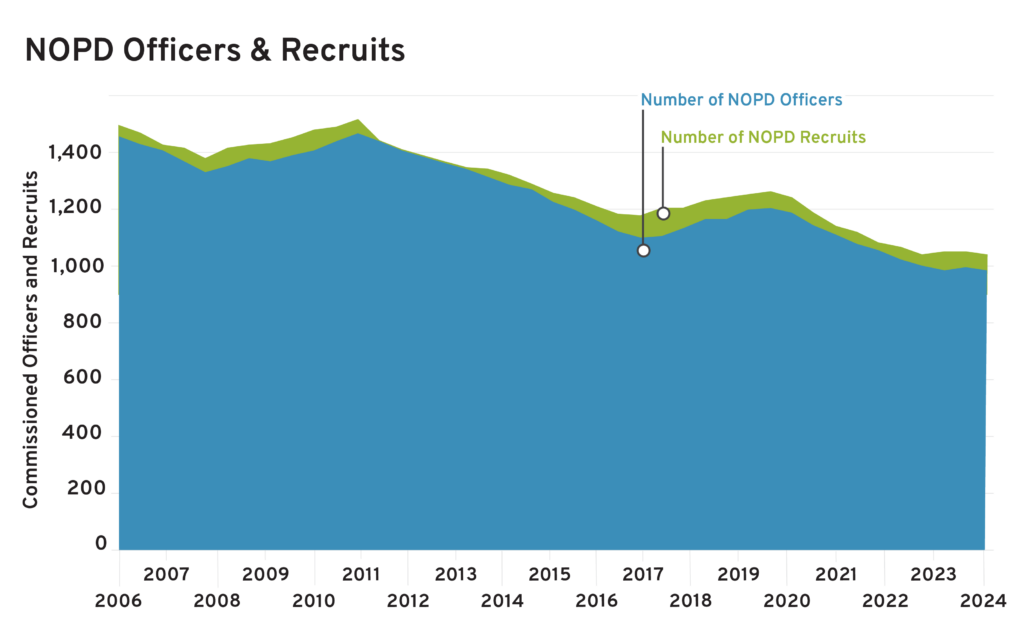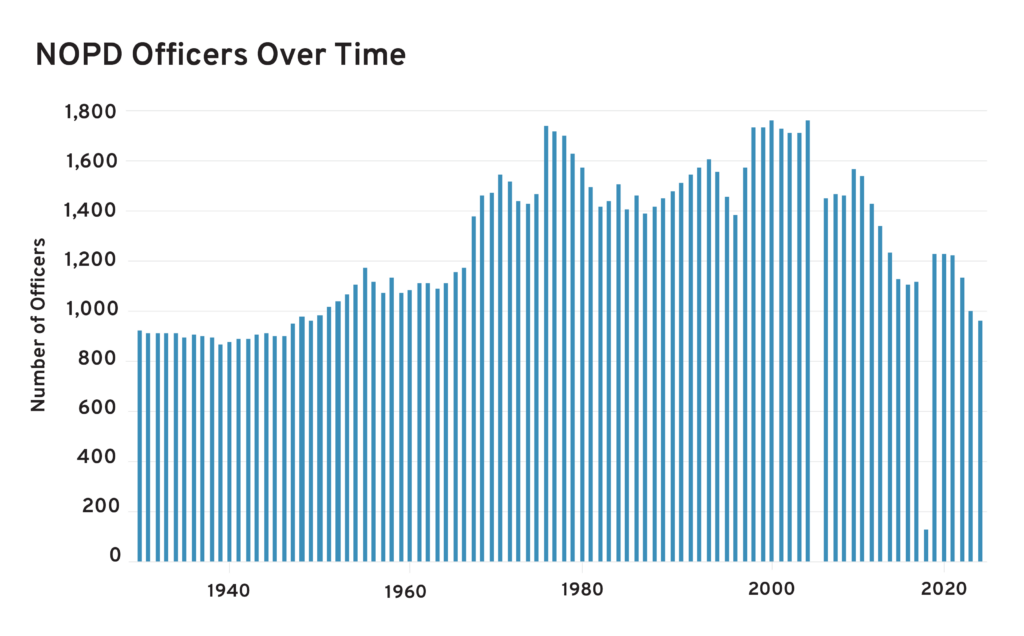Top Five Real Solutions to the Police Recruitment and Retention Crisis
It’s no secret that law enforcement agencies nationwide are struggling to recruit and retain qualified personnel. The labor shortage, which the International Association of Chiefs of Police (IACP) calls a crisis, is doing what the “defund the police” movement could not—namely, shrinking the size of U.S. law enforcement agencies.
One striking example is the New Orleans Police Department, which has shed approximately 40 percent of its workforce during the past 15 years. Both Chicago and Philadelphia’s police departments are about 11 percent smaller than they were just a few years ago, despite ramping up recruiting efforts. Fewer officers mean slower response times and higher crime rates.


Source: New Orleans Police Department
What is Causing the Exodus?
One proposed explanation is the so-called “Ferguson Effect,” or the idea that increased scrutiny in recent years has not only caused police agencies to step back enforcement, but has also been responsible for the spike in retirements and resignations. However, police-community relationships have been tested before, and even in the most contentious of times, the number of full-time sworn officers has not substantially decreased until now. Indeed, new evidence suggests that the Ferguson Effect’s influence on recruitment and retention has been less profound than initially believed.
Another theory is that officers simply perceive the job as riskier than ever before, and there is some evidence to indicate they are correct. From 2021 to 2023, 194 officers were killed in line of duty, more than any other consecutive three-year period in the past 20 years. In addition to safety concerns, officers are frustrated by low pay, long hours, high stress, and the loss of public trust. In all, less than 10 percent of officers are satisfied at work, and only 7 percent would encourage new candidates to apply.
The answer is not to set a lower bar for law enforcement candidates, as was recently done by the New York Police Department and Chicago Police Department. That only jeopardizes officer competency, risking public safety and running counter to what communities want. Another obvious place to look is compensation. While pay and benefits are of course critical, even the pull of traditionally generous law enforcement pensions is waning. Forward-thinking agencies are investing in perks with the flexibility and immediacy to appeal to a new generation of workers, most of whom do not plan to stay in one job their entire career.
Real Recruitment and Retention Solutions
Here are the five real solutions law enforcement leaders and local policymakers can use to bolster police recruitment and retention and draw from a larger, more diverse pool of talent:
1. Hiring and Retention Bonuses: Like any market, the law enforcement labor market is governed by supply and demand. Right now, demand for police officers is higher than ever, but the supply of candidates is shrinking. A 2024 study of career incentives found that financial incentives were the most significant factor influencing students’ willingness to apply for a career in policing. In the current inflationary environment, agencies must be prepared to offer compensation packages that reflect the unique risk and responsibilities of the job. The recent Recruit and Retain Act is designed to provide grants to cover the costs of sign-on bonuses, relocation assistance, tuition reimbursement, and more.
2. Emphasize Officer Wellness: Policing can take an emotional and physical toll, leading to injuries, medical retirements, and stress-related burnout. Tragically, police officers suicide rate is 54 percent higher than the civilian population. Many police agencies have specialized groups of peer volunteers trained to provide support to officers after critical incidents, but most of what officers do during a typical day, while stressful, falls outside the scope of critical care. Agencies should not wait for something bad to happen to offer their people health resources. Employee wellness programs can help bridge that gap. One example is the Sheriff’s Office in Sedgwick County, Kansas, which provides fitness equipment, yoga classes, gym memberships, and even catered food. Limited research indicates officers who maintain healthy physical fitness levels are significantly less likely to use lethal force.
3. Professional Development and Career Advancement: A career in law enforcement requires courageous men and women who are not only physically fit and knowledgeable about the law, but with the right temperament to wield authority in a responsible and professional manner. Offering structured opportunities for continuous growth and advancement can help agencies hang onto their best people. Specialized training in areas like cybersecurity, forensic analysis, and crisis negotiation can align officers’ professional skill with their personal competencies and interests. For those interested in leadership, the IACP offers training to prepare young officers for supervisory and management roles.
4. Modernize Hiring: To stay relevant in a competitive job market, many departments that once upon a time banned visible tattoos have loosened this prohibition, reflecting shifting societal norms. Social media is useful for targeting this younger, more tattooed demographic. Once a candidate is in the door, it is important to expedite the hiring process. A protracted, cumbersome ordeal can deter potential recruits. Streamlining hiring is not only about speed, but also about making the process applicant-friendly using online applications, revamped testing requirements, and interim employment opportunities for those waiting to start their academy training. Once someone is hired, an “entry interview” to learn why they are joining the force can be just as insightful as an exit interview about why someone is leaving.
5. Community Outreach: With confidence in police at record lows, rebuilding trust is necessary to make law enforcement careers more appealing. One way to accomplish this is to be more open and transparent with use-of-force data and other law enforcement information so the community can understand how it is being policed. Another strategy is to designate community liaisons to build personal connections and listen to community concerns. Problem-oriented policing strategies that quickly iterate based on community feedback demonstrate a concrete commitment to accountability that fosters an environment conducive to recruitment.
Conclusion
The recruitment and retention crisis in law enforcement is a market problem requiring market solutions. Pay and benefits will always be important, but officer wellness programs, modern recruitment methods, professional development, and community engagement all have a role to play as well. Implementing these solutions will not only make law enforcement careers more attractive in an increasingly competitive labor market, but also help retain the kind of dedicated professionals we need to protect our country.